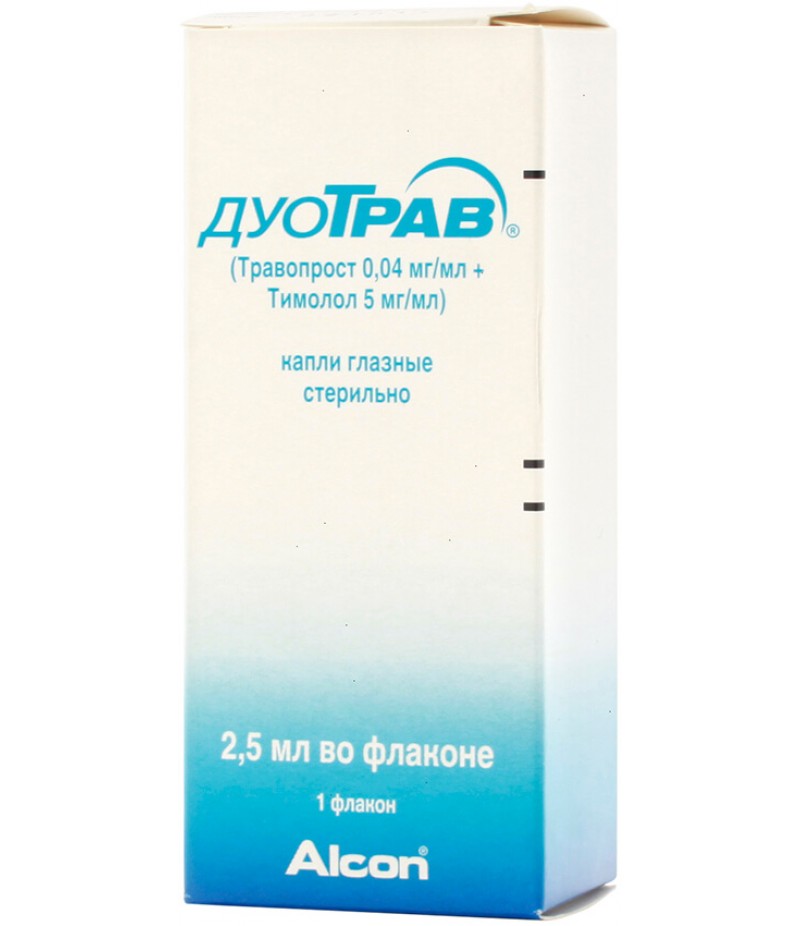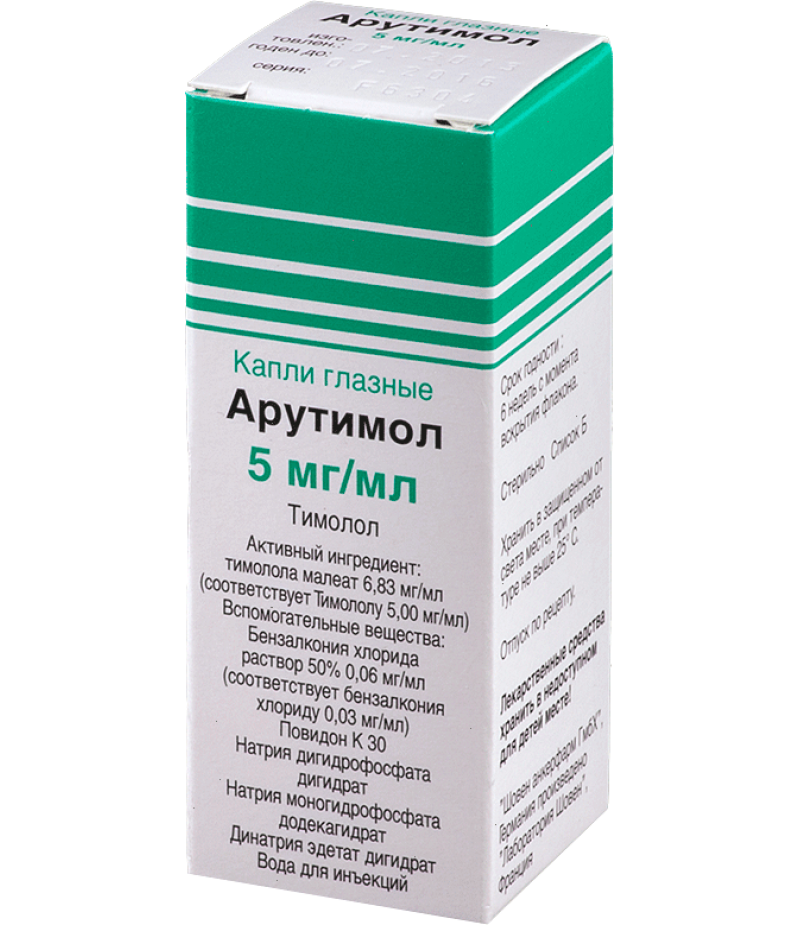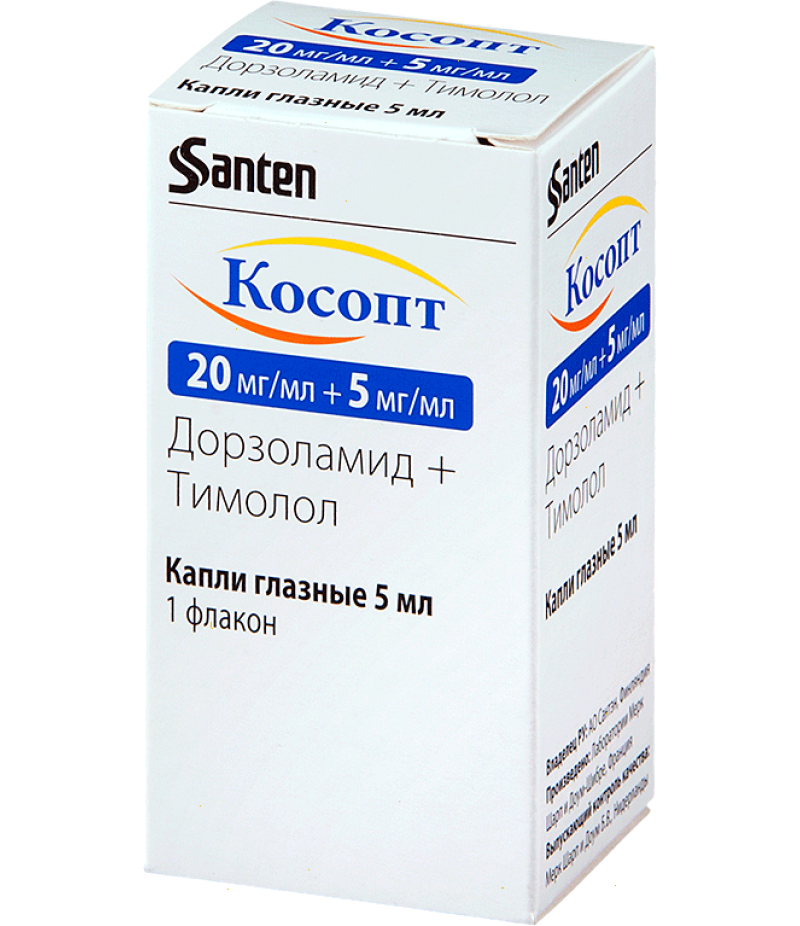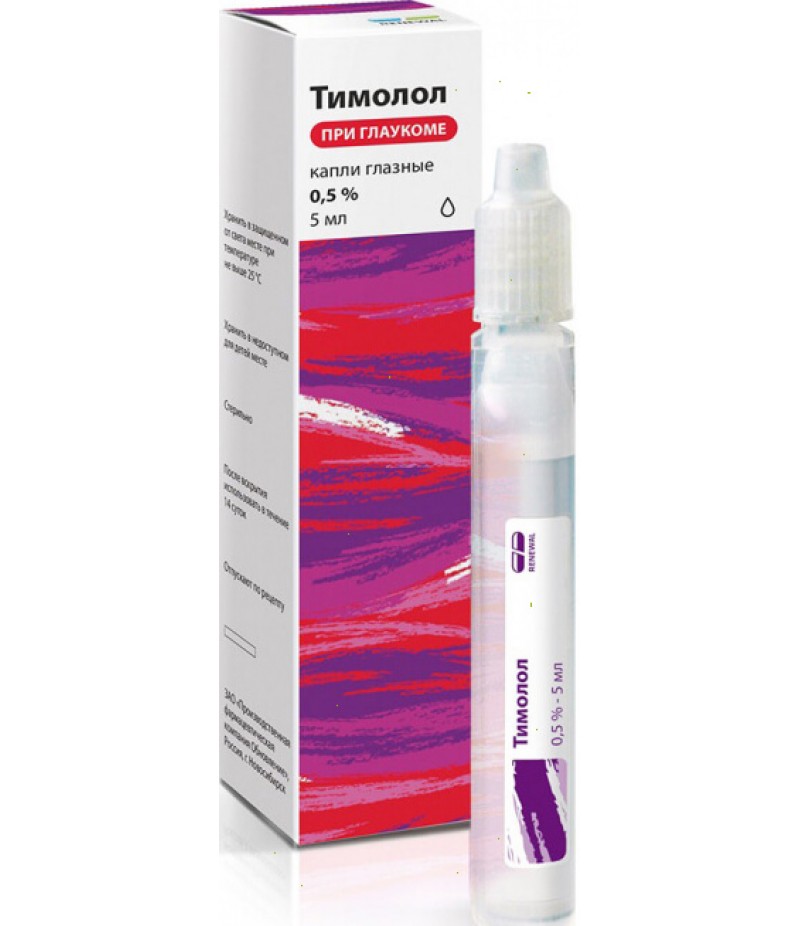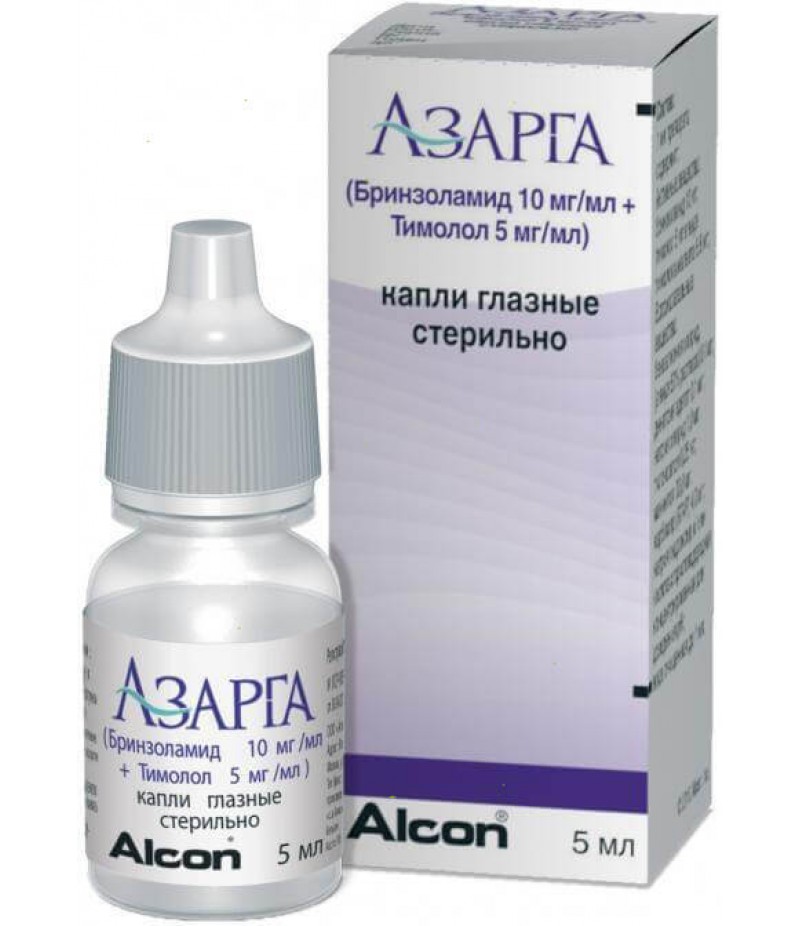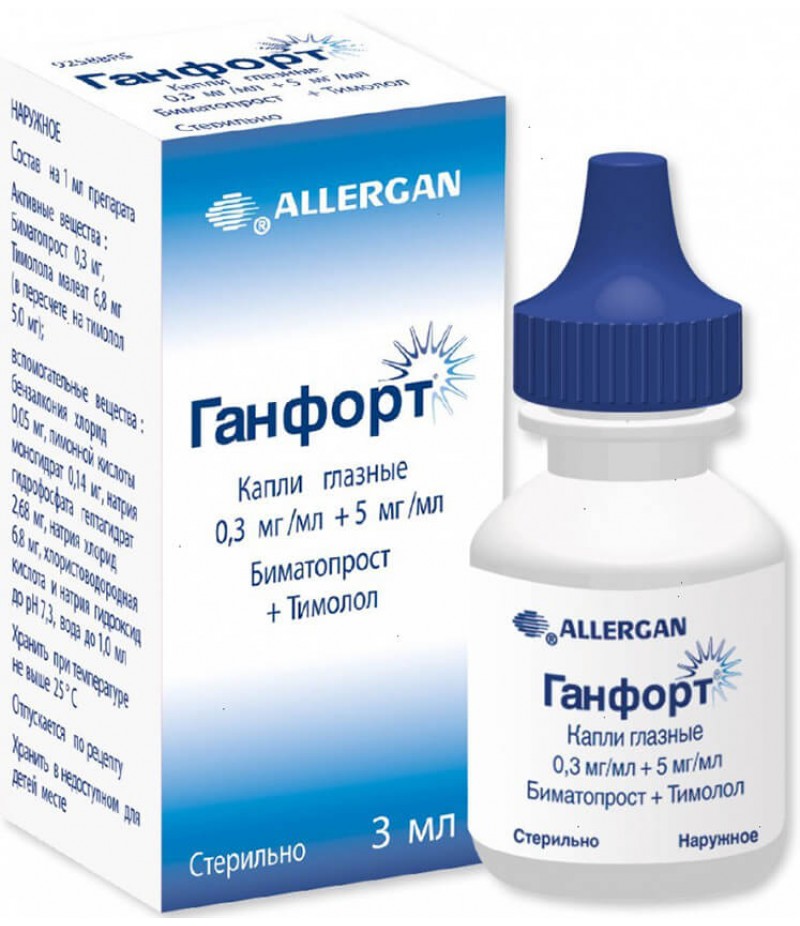DuoTrav drops 2.5ml
- $46.38
- 2 or more $45.50
- 3 or more $44.75
- Availability:In Stock
DuoTrav instruction for useTo buy DuoTrav eye drops just add it to your shopping cartComposition of 1 ml of solutionActive substances: travoprost 40 mg, timolol 5 mg (in the form of timolol maleate 6.
Tags: drops
DuoTrav instruction for use
To buy DuoTrav eye drops just add it to your shopping cart
Composition of 1 ml of solution
Active substances: travoprost 40 mg, timolol 5 mg (in the form of timolol maleate 6.8 mg)
Excipients: benzalkonium chloride, solution, equivalent to benzalkonium chloride, boric acid, disodium edetate, macrogol glyceryl hydroxy stearate, 1 trometamol, mannitol, tonometamol and / or hydrochloric acid concentrated to adjust pH, purified water.
1 Synonym: polyoxyethylene hydrogenated castor oil 40 (HCO-40).
Description: Transparent or slightly opalescent solution from colorless to light yellow color.
Pharmacotherapeutic group:
antiglaucoma (prostaglandin F2-alpha analogue synthetic + beta-blocker).
ATX code: S01ED51
pharmachologic effect of DuoTrav
Travoprost, a synthetic analogue of prostaglandin F2-alpha, is a highly selective agonist of prostaglandin FP receptors and reduces intraocular pressure by increasing the outflow of aqueous humor. The main mechanism of action of the drug is associated with an increase in out-scleral outflow. Has no significant effect on the production of aqueous humor.
Timolol is a non-selective beta-adrenergic blocker without sympathomimetic activity, does not have a direct depressive effect on the myocardium, does not have membrane-stabilizing activity. With topical application reduces intraocular pressure by reducing the formation of watery moisture and a slight increase in its outflow.
Intraocular pressure decreases approximately 2 hours after application, and the maximum effect is achieved after 12 hours. A significant decrease in intraocular pressure can persist for 24 hours after a single application of the drug.
Pharmacokinetics
Travoprost and timolol are absorbed through the cornea of the eye. In the cornea, hydrolysis of travoprost is carried out to a biologically active form - travoprost acid.
Travoprost after topical application is rapidly excreted from the plasma for an hour - the concentration in the blood plasma drops below the detection threshold - less than 0.01 ng / ml (it can vary from 0.011 to 0.02 ng / ml). The maximum concentration (Cmax) of timolol in blood plasma is 0.692 ng / ml and is maintained to the detection threshold for 12 hours, and timaxol Tmax is reached within one hour after topical application. T½ timolol is 4 hours after topical application of DuoTrav. Travoprost is excreted as inactive metabolites mainly with bile (61%). The free acid of travoprost and its metabolites are excreted by the kidneys. Less than 2% of travoprost is found in the urine as a free acid.
Timolol and the resulting metabolites are excreted mainly by the kidneys. About 20% of timolol is excreted unchanged, the rest - in the form of metabolites.
Indications for use
Decreased elevated intraocular pressure in open-angle glaucoma and intraocular hypertension in patients with beta-blockers or analogues of prostaglandin resistant to monotherapy.
Contraindications for DuoTrav
Hypersensitivity to the components of DuoTrav.
Bronchial asthma, bronchial asthma in history, severe chronic obstructive pulmonary disease, bronchial hyperreactivity, sinus bradycardia, atrioventricular blockade of grade II-III, decompensated chronic heart failure, cardiogenic shock, severe allergic rhinitis, corneal dystrophy, hypersensitivity to a group of beta-blockers, pregnancy, lactation, children under 18 years of age.
Carefully
Neovascular, closed-angle, narrow-angle glaucoma, pigmented and congenital glaucoma, open-angle glaucoma with pseudo-aphasia, pseudoexfoliation glaucoma; ophthalmic inflammatory diseases; aphakia, pseudofakia with a rupture of the posterior capsule of the lens, patients at risk of developing cystoid macular edema, iritis, uveitis.
Anaphylactic reactions. Patients with severe atopy or anaphylactic reactions to various allergens history receiving beta-blockers may be resistant to conventional doses of epinephrine for the treatment of anaphylactic reactions. System effects. Travoprost and timolol may undergo systemic absorption. Timolol with local use can cause the same side effects from the cardiovascular and respiratory systems, as well as systemic beta-blockers. It is necessary to monitor the patient's condition before and during therapy with timolol. Cases of severe respiratory and cardiovascular disorders, including death from bronchospasm in patients with bronchial asthma and death from heart failure with timolol, are described.
Beta-blockers should be used with caution in patients with a tendency to hypoglycemia or diabetes (especially with diabetes mellitus), because these drugs can mask the symptoms of acute hypoglycemia.
Beta-adrenoblockers can mask symptoms of hyperthyroidism and cause peripheral and central circulatory disorders and hypotension, as well as worsening of the condition with Prinzmetal angina pectoris.
Before the planned operation, beta-blockers should be gradually (not instantaneously!) Canceled 48 hours before the general anesthesia, tk. during general anesthesia, they can reduce the sensitivity of the myocardium to sympathetic stimulation necessary for the work of the heart.
Dosing and Administration
DuoTrav is instilled in 1 drop in the conjunctival sac of the eye 1 time per day, in the evening or in the morning at the same time.
To reduce the risk of developing systemic side effects, it is recommended after the installation of the drug to squeeze the nasolacrimal canal by pressing in the area of its projection at the inner corner of the eye.
If the dose has been missed, then the treatment should be continued with the next dose. The daily dose of the drug should not exceed 1 drop in the conjunctival sac of the eye 1 time per day.
Side effects of DuoTrav
Local. In 10% of cases, eye irritation and conjunctival hyperemia are observed. In 1-10% of cases - punctate keratitis, exudate in the anterior chamber, the pain and itching in the eyes, photophobia, conjunctival hemorrhage, corneal erosion, discomfort and foreign body sensation, decreased visual acuity, blurred vision, feeling of blurred vision, dry eyes , development of allergic conjunctivitis, increased lacrimation, irritation age, age of erythema, dermatitis, age, skin hyperpigmentation (periorbital), asthenopia, browning, thickening and lengthening eyelashes, blepharitis.
In 0.1-1% of cases - soreness, itching and edema of the eyelids, allergic reactions, edema of the conjunctiva, keratitis.
Systemic side effects. In 1-10% of cases - general anxiety, dizziness, headache, increase or decrease in blood pressure, bradycardia, arrhythmia, bronchospasm, urticaria, pain in the extremities.
In 0.1-1% of cases - shortness of breath, cough, throat irritation, increased levels of alanine aminotransferase and aspartate aminotransferase, contact dermatitis, changes in urine color, the feeling of thirst, the occurrence of postnasal drip syndrome. Possible side effects (frequency unknown) are: corneal damage, tachycardia, chest pain.
Travoprost: macular edema, uveitis, iritis, conjunctivitis, conjunctival follicles, crust formation on the edges of the eyelids, increased iris pigmentation, bronchial asthma, skin peeling.
Timolol: diplopia, conjunctivitis, ptosis century, hypoglycemia, depression, cerebrovascular accident, cerebral ischemia, syncope, paresthesia, myasthenia gravis, heart failure, arrhythmias, heart failure, atrioventricular block, palpitations, respiratory failure, nasal congestion, diarrhea, nausea, rash , alopecia, chest pain, asthenia.
Overdose with DuoTrav
Symptoms: irritation of the mucous membrane of the eye, hyperemia of the conjunctiva or episcleras, bradycardia, lowering of arterial pressure, bronchospasm and cardiac arrest. Treatment. It is recommended that the groove be immediately washed with water and symptomatic therapy should be performed. Hemodialysis is ineffective.
Interaction DuoTrav with other drugs
Studies on interactions with other drugs have not been conducted. There is a possibility of increasing the hypotensive effect or development of severe bradycardia with the simultaneous use of timolol with calcium channel blockers for ingestion, guanethidine, beta-adrenoblockers, antiarrhythmics, cardiac glycosides and parasympathomimetics. The development of hypertension after a sharp abolition of clonidine can be enhanced with simultaneous reception of beta-blockers.
Beta-blockers can increase the hypoglycemic effect of antidiabetics. Beta-blockers can mask symptoms of hypoglycemia.
DuoTrav can be used in combination with other local ophthalmic drugs to reduce intraocular pressure. In this case, the interval between their use should be at least 5 minutes.
It is not recommended simultaneous use of two local beta-blockers or two local analogues of prostaglandins!
special instructions
Local action
Travoprost can cause a gradual change in eye color by increasing the amount of brown pigment in melanocytes. Before starting treatment, patients should be informed about the possibility of changing eye color. Treatment of only one eye can lead to permanent heterochromia. Long-term effects on melanocytes and the effects of this effect are currently unknown. The change in the color of the iris of the eyes is slow and may go unnoticed for a number of months or years. This effect is revealed mainly in patients with mixed iris coloration, for example, blue-brown, gray-brown, green-brown or yellow-brown; However, it can also be observed in patients with brown eyes. Typically, brown pigmentation spreads concentrically around the pupil to the periphery of the iris of the eyes, while the entire iris or parts of it can acquire a more intense brown color. After the drug was discontinued, there was no further increase in the amount of brown pigment, but the already developed color change may be irreversible.
DuoTrav can cause darkening, thickening and lengthening of eyelashes / or an increase in their number; rarely - darkening of the skin of the eyelids. The mechanism of these changes is not currently established.
The drug contains a preservative of benzalkonium chloride, which can be absorbed by contact lenses. Before using the drug, the lens should be removed and installed back no earlier than 15 minutes after the drug is used.
If the patient after the application of DuoTrav temporarily reduces clearness of vision, it is not recommended to drive the car and engage in activities requiring increased attention before its restoration.
Do not touch the tip of the dropper bottle to any surface to avoid contamination of the dropper and its contents. The bottle must be closed after each use.
Form of issue
Eye drops.
For 2.5 ml in the bottle-drip «Droptainer» made of polypropylene with polypropylene lid.
For 1 bottle in a foil bag with instructions for medical use in a pack of cardboard.
Shelf life - 3 years.
Do not use after the expiry date printed on the package. Use within 4 weeks after opening the vial.
Storage conditions
At a temperature of 2-25 ° C, out of reach of children.
To buy DuoTrav you don't need a prescription.

